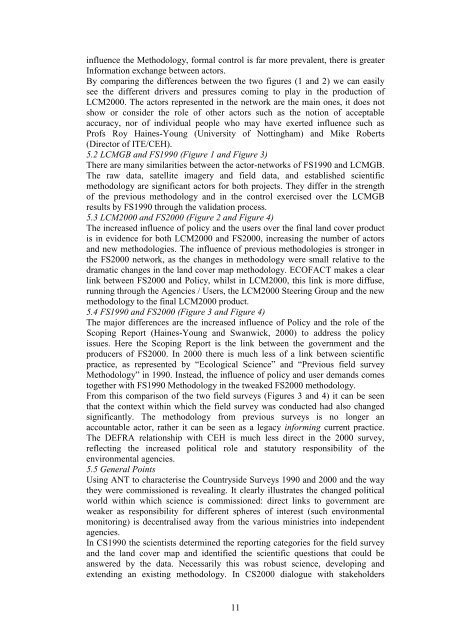Actor Network Theory - Leicester Research Archive - University of ...
Actor Network Theory - Leicester Research Archive - University of ...
Actor Network Theory - Leicester Research Archive - University of ...
You also want an ePaper? Increase the reach of your titles
YUMPU automatically turns print PDFs into web optimized ePapers that Google loves.
influence the Methodology, formal control is far more prevalent, there is greater<br />
Information exchange between actors.<br />
By comparing the differences between the two figures (1 and 2) we can easily<br />
see the different drivers and pressures coming to play in the production <strong>of</strong><br />
LCM2000. The actors represented in the network are the main ones, it does not<br />
show or consider the role <strong>of</strong> other actors such as the notion <strong>of</strong> acceptable<br />
accuracy, nor <strong>of</strong> individual people who may have exerted influence such as<br />
Pr<strong>of</strong>s Roy Haines-Young (<strong>University</strong> <strong>of</strong> Nottingham) and Mike Roberts<br />
(Director <strong>of</strong> ITE/CEH).<br />
5.2 LCMGB and FS1990 (Figure 1 and Figure 3)<br />
There are many similarities between the actor-networks <strong>of</strong> FS1990 and LCMGB.<br />
The raw data, satellite imagery and field data, and established scientific<br />
methodology are significant actors for both projects. They differ in the strength<br />
<strong>of</strong> the previous methodology and in the control exercised over the LCMGB<br />
results by FS1990 through the validation process.<br />
5.3 LCM2000 and FS2000 (Figure 2 and Figure 4)<br />
The increased influence <strong>of</strong> policy and the users over the final land cover product<br />
is in evidence for both LCM2000 and FS2000, increasing the number <strong>of</strong> actors<br />
and new methodologies. The influence <strong>of</strong> previous methodologies is stronger in<br />
the FS2000 network, as the changes in methodology were small relative to the<br />
dramatic changes in the land cover map methodology. ECOFACT makes a clear<br />
link between FS2000 and Policy, whilst in LCM2000, this link is more diffuse,<br />
running through the Agencies / Users, the LCM2000 Steering Group and the new<br />
methodology to the final LCM2000 product.<br />
5.4 FS1990 and FS2000 (Figure 3 and Figure 4)<br />
The major differences are the increased influence <strong>of</strong> Policy and the role <strong>of</strong> the<br />
Scoping Report (Haines-Young and Swanwick, 2000) to address the policy<br />
issues. Here the Scoping Report is the link between the government and the<br />
producers <strong>of</strong> FS2000. In 2000 there is much less <strong>of</strong> a link between scientific<br />
practice, as represented by ―Ecological Science‖ and ―Previous field survey<br />
Methodology‖ in 1990. Instead, the influence <strong>of</strong> policy and user demands comes<br />
together with FS1990 Methodology in the tweaked FS2000 methodology.<br />
From this comparison <strong>of</strong> the two field surveys (Figures 3 and 4) it can be seen<br />
that the context within which the field survey was conducted had also changed<br />
significantly. The methodology from previous surveys is no longer an<br />
accountable actor, rather it can be seen as a legacy informing current practice.<br />
The DEFRA relationship with CEH is much less direct in the 2000 survey,<br />
reflecting the increased political role and statutory responsibility <strong>of</strong> the<br />
environmental agencies.<br />
5.5 General Points<br />
Using ANT to characterise the Countryside Surveys 1990 and 2000 and the way<br />
they were commissioned is revealing. It clearly illustrates the changed political<br />
world within which science is commissioned: direct links to government are<br />
weaker as responsibility for different spheres <strong>of</strong> interest (such environmental<br />
monitoring) is decentralised away from the various ministries into independent<br />
agencies.<br />
In CS1990 the scientists determined the reporting categories for the field survey<br />
and the land cover map and identified the scientific questions that could be<br />
answered by the data. Necessarily this was robust science, developing and<br />
extending an existing methodology. In CS2000 dialogue with stakeholders<br />
11














